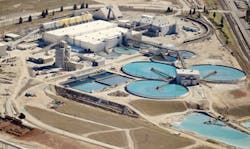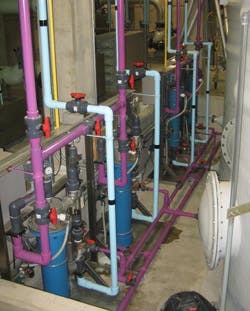Considerations for Optimizing Performance in Industrial Water Treatment
By Greg Kriebel
Since the beginning of time, people have needed to treat the water they consume and use for cooking, bathing and cleaning. Likewise, they have also needed to find ways to properly treat and dispose of the water that has been fouled through the course of its use. In latter centuries, industrial production activities have intensified that need -- spurring the water/wastewater treatment industry grow to $136 billion in revenues in 2011 in the United States, and to an annual rate of growth anywhere between 3.0% and 4.5%.
Industrial water treatment can refer to a variety of things: water taken from a nearby river might be treated for use as boiler or cooling-tower makeups; in oil and gas, water used or produced during the drilling and recovery process might be treated and sold to farmers for use in field-irrigation activities.
Regardless of the application, an integrated water treatment system, with many different types of equipment working hand-in-hand in a straight-line treatment process, will deliver the most cost-effective and efficient industrial water treatment, ultimately making industrial water safe for disposal or reuse.
With regard to particulate removal, for example. metering and peristaltic (hose) pumps and polymer makedown systems are in integral part of the treatment process. Most of the water used or produced in industrial applications contains some level of solid particles. Particle-laden water can't be used, for example, in a boiler that provides steam to a turbine during power generation, lest the turbine become fouled and damaged.
Simply recognizing the presence of particulates in water and successfully removing them, however, are two different things. Some of the particles -- which can be anything from bacteria and plant material to dirt or minuscule pieces of crushed stone -- are so small that their response to gravity is very low. In other words, they don't fall through water at a consistent rate because their mass is so small and not impacted by gravity. This means that it may take many hours, days or even weeks for the particles to settle as little as a foot. This unpredictable settling rate is unacceptable for a wastewater treatment system, so the particles need some help in settling or clumping.
To speed the settling process, the water treatment facility must turn to the introduction of a coagulant or flocculant. Two of the more popular types of coagulants/flocculants that are used in water/wastewater treatment are alum and ferric chloride.
Alum is a more economical way to say hydrated potassium aluminum sulfate. It has been used since Roman times to aid in the purification of drinking and industrial-process water. Alum coaxes negatively charged colloidal particles to clump together so they will be able to be more easily removed from settling basins.
Ferric chloride is another name for Iron (III) chloride. It undergoes hydrolysis when dissolved in water, which gives it the ability to sufficiently form suspended solid particles into flocs.
While quite effective in creating flocs, the flocs that are formed by alum and ferric chloride are held together rather loosely, which means that they can break apart if agitated as they settle in the clarifier or settling basin. Eliminating this break-up potential requires the introduction of a polymer solution that helps form more efficient flocs. The polymer takes the neutralized solid particle clumps and binds them together more tightly.
The clumps that settle in the basin form sludge. The use of alum by itself leads to the generation of a large amount of sludge; the introduction of polymer helps further coagulate the sludge. However, the sludge that is produced still needs to be removed and disposed of. Accumulated sludge can be collected and sent away -- to a centrifuge, for example -- or just piled up on the ground outside the water treatment facility, allowed to dry and then removed via front-end loader and dump truck.
Removing the sludge from the water requires a pump that can run dry and won't be bothered by abrasive materials. In other words, a pump that has the capability to take whatever flows into it -- no matter its makeup -- and deliver it out the discharge side in that same form.
One can see how particulate removal is basically a three-stage process where each component must work hand-in-hand: initial floc formation with alum and ferric chloride; clump strengthening with polymer; and sludge removal and disposal.
Each stage requires a different type of technology, which can often have the wastewater plant operator moving in many different directions to identify a solution. To address this, an operator might consider a vendor who can supply a variety of equipment solutions: metering pumps, polymer makedown systems and peristaltic pumps designed to work together to create an efficient and cost-effective industrial wastewater treatment process.
Although not all manufacturers of wastewater treatment equipment offer full lines of pumping and polymer-blending technology for the required water treatment applications, some do. Seeking out a vendor that can provide this allows the water treatment facility access to a one-company-one-source solution that covers its needs from start to finish.
About the Author: Greg Kriebel is with Fluid Dynamics™, a division of Neptune™ Chemical Pump Co., in North Wales, Pa. He can be contacted at [email protected] or at 215-699-8700, ext. 3361.




